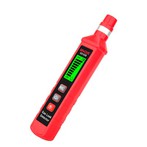Two Methods for Measuring Diodes with Digital Multimeters
I believe many people are familiar with diodes, which can be tested using the diode range of a multimeter. Multimeters are divided into pointer type and digital type multimeters. How to operate them specifically? In this article, the editor will explain in detail: 1. When using a pointer type multimeter to measure the forward resistance of a diode, the black probe should be connected to the positive terminal of the diode, and the red probe should be connected to the negative terminal of the diode. After replacing the probe, the reverse resistance of the diode can be measured. The resistance range of the forward resistance of ordinary diodes is usually 3-8K Ω, and the resistance of the reverse resistance should be infinite. Off road detection: Place the multimeter in the "Rx1k" position, connect the black probe to the positive terminal of diode RM11 and the red probe to its negative terminal. The measured forward resistance is about 7.2k Ω, as shown in Figure 1; Place the multimeter in the "Rx10k" position and swap the probes to measure the resistance of its reverse resistor, which is infinite, as shown in Figure 2. If the resistance of the forward resistor is too high or infinite, it indicates that the diode has a high on resistance or an open circuit; If the resistance of the reverse resistor is too small or zero, it indicates that the diode is leaking or breakdown.
On the road inspection. As shown in the figure, place the multimeter in the "Rxl" position and measure the forward resistance of the diode. The resistance should be over ten ohms, while the resistance of the reverse resistor should be infinite. If the resistance of the forward resistor is too high, it indicates that the diode has a high on resistance or an open circuit; If the resistance of the reverse resistor is too small or zero, it indicates that the diode is leaking or broken down. 2. When using a digital multimeter to measure a diode, the diode gear should be used first. Connect the red probe to the positive terminal of the diode and the black probe to the negative terminal of the diode. The measured value is its forward conduction voltage drop; After swapping the probes, the reverse conduction voltage drop of the diode can be measured, which is usually infinite. There are two methods for detecting diodes using a digital multimeter: off circuit detection and on circuit detection. However, regardless of the detection method, the multimeter should be placed in the "diode" position.
When detecting ordinary diodes outside the road, place the digital multimeter in the "diode" position, connect the red probe to the positive terminal of the diode, and connect the black probe to the negative terminal of the diode. At this time, the displayed voltage drop value on the screen is "0.5~0.7", as shown in Figure (a); After replacing the probes, the conduction voltage drop value is infinite (most digital multimeters display "1", a few display "OL"), as shown in Figure (b). If there is a significant difference in values during testing, it indicates that the tested diode is damaged.






